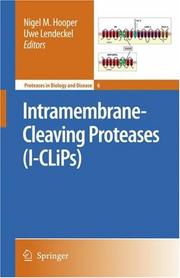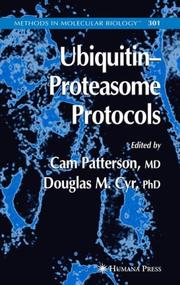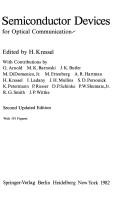| Listing 1 - 9 of 9 |
Sort by
|

ISBN: 1280618671 9786610618675 0387251510 0387251499 1441937757 Year: 2005 Volume: v. 4 Publisher: Dordrecht : Springer,
Abstract | Keywords | Export | Availability | Bookmark
 Loading...
Loading...Choose an application
- Reference Manager
- EndNote
- RefWorks (Direct export to RefWorks)
The ADAM Family of Proteases provides the first comprehensive review of the roles of ADAMs and the related ADAMTS proteases in biology and disease. Although a few members of the ADAM (a disintegrin and metalloprotease) family have been known for some time, it is only in recent years through advances in genome sequencing that the large size of this family of zinc metalloproteases has become apparent. These proteins have multiple domains including a protease domain and a disintegrin domain. A branch of the family, called ADAMTS, also have thrombospondin-like motifs. The role of ADAMs and ADAMTS members in a diversity of biological processes is gradually coming to light. For example, some ADAMs have critical roles in the ectodomain shedding of membrane proteins including tumour necrosis factor-a, the cell signalling molecule Notch and the Alzheimer’s amyloid precursor protein. Other ADAM and ADAMTS family members have key roles to play in sperm function and fertility, collagen processing, development, cardiac hypertrophy and arthritis.
Proteolytic enzymes. --- Proteinase. --- Brain --- Brain chemistry. --- Pathophysiology. --- Peptide hydrolases --- Proteases --- Hydrolases --- Cerebrum --- Mind --- Central nervous system --- Head --- Proteolytic enzymes --- Neurochemistry --- Analysis and chemistry --- Biochemistry. --- Biochemistry, general. --- Biological chemistry --- Chemical composition of organisms --- Organisms --- Physiological chemistry --- Biology --- Chemistry --- Medical sciences --- Composition

ISBN: 1280944064 9786610944064 1402063113 1402063105 9048176042 Year: 2007 Publisher: Dordrect : Springer,
Abstract | Keywords | Export | Availability | Bookmark
 Loading...
Loading...Choose an application
- Reference Manager
- EndNote
- RefWorks (Direct export to RefWorks)
In recent years a growing number of proteases have been identified that catalyse peptide bond hydrolysis in the plane of the cellular membrane. These so-called ‘intramembrane-cleaving proteases’ (I-CLiPs) are involved in a diverse range of cellular processes, including cell regulation, signalling, quorum sensing, protein processing, lipid metabolism and the unfolded protein response. Some I-CLiPs play critical roles in diseases such as Alzheimer’s and viral infection. The authors, who are all world leaders in this exciting field of cell biology, provide an overview of the various proteases including recent data derived from the structural determination of some of the I-CliPs, and discuss the various roles that these proteases play in biology and disease. The aim of this book is to provide an update on this emerging group of unusual but important proteases for both the specialist and those with a broader interest in proteases. Amongst the target audience will be protease researchers, enzymologists, those working in academia and the pharmaceutical industry on biological processes and diseases involving I-CLiPs.
Endopeptidases. --- Proteolytic enzymes --- Metabolism. --- Peptide hydrolases --- Proteases --- Hydrolases --- Peptide peptidohydrolases --- Peptidase --- Pathology. --- Neurosciences. --- Cytology. --- Cell Biology. --- Cell biology --- Cellular biology --- Biology --- Cells --- Cytologists --- Neural sciences --- Neurological sciences --- Neuroscience --- Medical sciences --- Nervous system --- Disease (Pathology) --- Diseases --- Medicine --- Medicine, Preventive --- Cell biology.

ISBN: 1280359277 9786610359271 1592598951 1588292525 9781588292520 9781592598953 1617374539 Year: 2005 Publisher: Totowa, NJ Humana Press :Imprint: Humana
Abstract | Keywords | Export | Availability | Bookmark
 Loading...
Loading...Choose an application
- Reference Manager
- EndNote
- RefWorks (Direct export to RefWorks)
The targeted addition of ubiquitin to proteins is now known to regulate many cellular events, with the enzymes involved in protein ubiquitination linked to a variety of clinical problems, such as cancer, heart disease, and immune dysfunction. In Ubiquitin-Proteasome Protocols, hands-on leaders in the field, many of whom originally developed the methods they describe, detail cutting-edge techniques for studying ubiquitin-dependent protein degradation via the proteasome. The topics covered range broadly from basic biochemistry to cellular assays to discovery techniques using mass spectrometric analysis. These biochemical and cellular methods are necessary to explore the ubiquitin-proteasome system and ubiquitin-proteasome- dependent functions. The protocols follow the successful Methods in Molecular Biology™ series format, each offering step-by-step laboratory instructions, an introduction outlining the principle behind the technique, lists of the necessary equipment and reagents, and tips on troubleshooting and avoiding known pitfalls. State-of-the-art and user-friendly, Ubiquitin-Proteasome Protocols offers novice and experienced bench scientists alike a thorough compendium of readily reproducible techniques that will accelerate discovery, enhance productivity, and permit manipulation of the system for varied research purposes.
Electronic books. -- local. --- Proteolytic enzymes -- Laboratory manuals. --- Ubiquitin -- Laboratory manuals. --- Multienzyme Complexes --- Ubiquitin --- Cysteine Endopeptidases --- Multiprotein Complexes --- Enzymes --- Cysteine Proteases --- Ubiquitins --- Endopeptidases --- Peptide Hydrolases --- Macromolecular Substances --- Proteins --- Enzymes and Coenzymes --- Hydrolases --- Chemicals and Drugs --- Amino Acids, Peptides, and Proteins --- Proteolytic enzymes --- Cysteine Endopeptidases. --- Multienzyme Complexes. --- Ubiquitine --- Enzymes protéolytiques --- metabolism. --- Laboratory manuals --- Manuels de laboratoire --- EPUB-LIV-FT SPRINGER-B LIVBIOLO --- Peptide hydrolases --- Proteases --- High mobility protein 20 --- HMP-20 --- Biochemistry. --- Biochemistry, general. --- Biological chemistry --- Chemical composition of organisms --- Organisms --- Physiological chemistry --- Biology --- Chemistry --- Medical sciences --- Composition --- Laboratory manuals.
Book
ISBN: 9400726007 904812347X 9786612331138 1282331132 9048123488 Year: 2009 Publisher: Dordrecht : Springer-Verlag,
Abstract | Keywords | Export | Availability | Bookmark
 Loading...
Loading...Choose an application
- Reference Manager
- EndNote
- RefWorks (Direct export to RefWorks)
The 8th volume in the Proteases in Biology and Disease series focuses on the role of proteases in virus function and their potential as anti-viral targets. Viral infections are still difficult to threat and some remained life-threatening diseases in spite of antiviral drug research over decades. Proteases are still regarded as an Achilles’ heel of the pathogens and, thus, protease inhibitors may help to handle the known and the emerging viral threads. The book discusses viral proteases of the most important pathogenic viruses, responsible for severe diseases: AIDS, SARS, Hepatitis, Cytomegalovirus, T-cell lymphotropic virus, Picornavirus. This book focuses specifically on the viral proteases, crucial prerequisites for viral entry into cells and viral replication. Viral proteases represent an important pharmaceutical target. The current stage of protease inhibitor development and therapy are summarised and discussed by experts in the field. This volume represents a timely and valuable continuation of the Proteases in Biology and Disease series. The reader will learn the potential for proteases as targets for effective anti-virals. This book will be a valuable source of information on viral proteases and provoke further research in this important field.
Virus inhibitors. --- Virus inhibitors --- Peptide Hydrolases --- Antiviral Agents --- Protease Inhibitors --- Viruses --- Organisms --- Anti-Infective Agents --- Hydrolases --- Enzyme Inhibitors --- Therapeutic Uses --- Enzymes --- Molecular Mechanisms of Pharmacological Action --- Pharmacologic Actions --- Enzymes and Coenzymes --- Chemical Actions and Uses --- Chemicals and Drugs --- Pharmacy, Therapeutics, & Pharmacology --- Health & Biological Sciences --- Protease inhibitors. --- Proteolytic enzymes. --- Peptide hydrolases --- Proteases --- Proteolytic enzyme inhibitors --- Proteolytic enzymes --- Inhibitors --- Medicine. --- Immunology. --- Medical microbiology. --- Virology. --- Medicinal chemistry. --- Infectious diseases. --- Biomedicine. --- Medical Microbiology. --- Biomedicine general. --- Medicinal Chemistry. --- Infectious Diseases. --- Microbiology --- Immunobiology --- Life sciences --- Serology --- Clinical sciences --- Medical profession --- Human biology --- Medical sciences --- Pathology --- Physicians --- Chemistry, Medical and pharmaceutical --- Chemistry, Pharmaceutical --- Drug chemistry --- Drugs --- Medical chemistry --- Medicinal chemistry --- Pharmacochemistry --- Chemistry --- Enzyme inhibitors --- Microbiology. --- Medical virology. --- Biochemistry. --- Emerging infectious diseases. --- Emerging infections --- New infectious diseases --- Re-emerging infectious diseases --- Reemerging infectious diseases --- Communicable diseases --- Biological chemistry --- Chemical composition of organisms --- Physiological chemistry --- Biology --- Medical microbiology --- Virology --- Virus diseases --- Microbial biology --- Microorganisms --- Composition --- Health Workforce --- Biomedicine, general.
Book
ISBN: 128179189X 9786611791896 0387690573 0387690565 Year: 2008 Publisher: New York : Springer,
Abstract | Keywords | Export | Availability | Bookmark
 Loading...
Loading...Choose an application
- Reference Manager
- EndNote
- RefWorks (Direct export to RefWorks)
Proteases that act in the extracellular environment have been historically associated with tumorigenesis and metastasis by virtue of their ability to carry out "path-clearing" for cancer cells. In the past few years it has become clear that they also shape the pericellular signaling environment, with profound consequences for cell fate and phenotype in both normal development and disease states. The repertoire of proteases that cells and tissues coordinately regulate in order to modulate their local environment is the DEGRADOME – which in humans is represented by at least 569 proteases in five catalytic classes. "The Cancer Degradome: Proteases in Cancer Biology" , edited by Dylan Edwards, Francesco Blasi, Gunilla-Høyer-Hansen and Bonnie Sloane, covers recent knowledge of the composition of the Degradome, how it can be studied using modern approaches such as transcriptomics and mass spectrometry; how protease activity can be imaged both in vitro and in vivo; how gene knockout mice have improved our knowledge of the roles of proteases in cancer; the links that have emerged between proteolysis and cell signaling; how the Degradome can be a useful source of diagnostic and prognostic markers; and finally new approaches to target proteolysis for therapy.
Cancer --- Proteolytic enzymes. --- Molecular aspects. --- Peptide hydrolases --- Proteases --- Hydrolases --- Oncology. --- Human genetics. --- Microbiology. --- Immunology. --- Medical virology. --- Medicine. --- Cancer Research. --- Human Genetics. --- Medical Microbiology. --- Virology. --- Molecular Medicine. --- Clinical sciences --- Medical profession --- Human biology --- Life sciences --- Medical sciences --- Pathology --- Physicians --- Medical microbiology --- Virology --- Virus diseases --- Immunobiology --- Serology --- Microbial biology --- Biology --- Microorganisms --- Genetics --- Heredity, Human --- Physical anthropology --- Tumors --- Health Workforce --- Cancer research. --- Medical microbiology. --- Molecular biology. --- Microbiology --- Cancer research --- Molecular biochemistry --- Molecular biophysics --- Biochemistry --- Biophysics --- Biomolecules --- Systems biology
Book
ISBN: 3540851062 9786611876333 128187633X 3540851070 Year: 2009 Publisher: Berlin, Heidelberg : Springer Berlin Heidelberg : Imprint: Springer,
Abstract | Keywords | Export | Availability | Bookmark
 Loading...
Loading...Choose an application
- Reference Manager
- EndNote
- RefWorks (Direct export to RefWorks)
The ubiquitin system plays an essential role in numerous cellular processes by controlling protein stability and function. An understanding of the mechanisms governing these processes is likely to allow the identification of novel targets for pharmacological intervention. This work covers the developments in this field.
Ubiquitin. --- Ubiquitin --- Proteasome Endopeptidase Complex --- Ubiquitins --- Peptide Hydrolases --- Multienzyme Complexes --- Proteins --- Enzymes --- Hydrolases --- Multiprotein Complexes --- Amino Acids, Peptides, and Proteins --- Chemicals and Drugs --- Macromolecular Substances --- Enzymes and Coenzymes --- Animal Biochemistry --- Pathology --- Medicine --- Human Anatomy & Physiology --- Health & Biological Sciences --- High mobility protein 20 --- HMP-20 --- Medicine. --- Medical biochemistry. --- Medicine & Public Health. --- Medical Biochemistry. --- Biomedicine general. --- Medicine/Public Health, general. --- Biochemistry. --- Clinical sciences --- Medical profession --- Human biology --- Life sciences --- Medical sciences --- Physicians --- Biological chemistry --- Chemical composition of organisms --- Organisms --- Physiological chemistry --- Biology --- Chemistry --- Composition --- Health Workforce --- Biomedicine, general. --- Medical biochemistry --- Pathobiochemistry --- Pathological biochemistry --- Biochemistry --- Clinical biochemistry.
Book
ISBN: 3540790454 9786612290756 1282290754 3540790462 Year: 2009 Publisher: New York : Springer,
Abstract | Keywords | Export | Availability | Bookmark
 Loading...
Loading...Choose an application
- Reference Manager
- EndNote
- RefWorks (Direct export to RefWorks)
The demand for cosmetic procedures by male patients has increased in recent years. With this trend has come the realization that male aesthetic needs are different from female aesthetic needs. This book is the first hands-on guide dedicated exclusively to the aesthetic treatment of the male patient, and provides cosmetic surgeons with important information on how to obtain a natural male look for such patients. It explains facial aesthetics and the aging process in men, as well as the current aesthetic medicine techniques available. It also offers valuable strategies for avoiding and treating undesired results. Written by internationally known experts in the field, this unique guide enables cosmetic surgeons to achieve the best possible treatment outcomes, as well as increased satisfaction in male patients.
Men -- Patients. --- Skin -- Aging -- Treatment. --- Surgery, Plastic. --- Epidemiologic Factors --- Skin and Connective Tissue Diseases --- Bacterial Proteins --- Therapeutics --- Metalloendopeptidases --- Head --- Health --- Bacterial Toxins --- Public Health --- Body Regions --- Proteins --- Diseases --- Metalloproteases --- Toxins, Biological --- Population Characteristics --- Analytical, Diagnostic and Therapeutic Techniques and Equipment --- Quality of Health Care --- Endopeptidases --- Peptide Hydrolases --- Anatomy --- Health Care Quality, Access, and Evaluation --- Environment and Public Health --- Health Care --- Amino Acids, Peptides, and Proteins --- Biological Factors --- Chemicals and Drugs --- Hydrolases --- Enzymes --- Enzymes and Coenzymes --- Botulinum Toxins --- Men's Health --- Sex Factors --- Skin Diseases --- Cosmetic Techniques --- Face --- Surgery & Anesthesiology --- Medicine --- Health & Biological Sciences --- Dermatology --- Plastic Surgery --- Dermatology. --- Aesthetic surgery --- Cosmetic surgery --- Plastic surgery --- Reconstructive surgery --- Surgery, Aesthetic --- Surgery, Cosmetic --- Surgery, Reconstructive --- Medicine. --- Ophthalmology. --- Otorhinolaryngology. --- Plastic surgery. --- Medicine & Public Health. --- Plastic Surgery. --- Skin --- Transplantation of organs, tissues, etc. --- Plastic surgeons --- Surgery. --- Ear, nose, and throat diseases --- ENT diseases --- Otorhinolaryngology --- Surgery, Primitive --- Eye
Book
ISBN: 1627038531 1603272801 9786611986544 1281986542 160327281X Year: 2009 Publisher: Totowa, NJ : Humana Press,
Abstract | Keywords | Export | Availability | Bookmark
 Loading...
Loading...Choose an application
- Reference Manager
- EndNote
- RefWorks (Direct export to RefWorks)
More than one in six men will develop prostate cancer in their lifetime. In recent years there has been an explosion of information regarding PSA screening and biomarkers for the disease. In Prostate Cancer Screening, Second Edition, the world’s leading experts on prostate cancer detection update the first edition with the latest findings. The book incorporates a series of thoughtful and cutting-edge works from the world’s experts in prostate cancer screening, ranging from the current status quo of prostate cancer screening across the globe to consensus on optimal utilization of the traditional PSA and DRE tests, to cutting-edge research in new biomarkers, biomeasures, and extended risk algorithms for prostate cancer. An additional chapter covers family-based linkage analysis as well as possible pitfalls in prostate cancer biomarker evaluation studies. Timely and authoritative, Prostate Cancer Screening, Second Edition, is an essential text for urologists, oncologists and family physicians, as well as researchers in the biomarker industry who seek methods to better develop and support markers and measures of prostate cancer.
Medical screening. --- Prostate --Cancer --Diagnosis. --- Prostate --- Medical screening --- Mass Screening --- Prostate-Specific Antigen --- Prostatic Neoplasms --- Diagnostic Techniques and Procedures --- Antigens, Neoplasm --- Tumor Markers, Biological --- Diagnostic Services --- Kallikreins --- Health Surveys --- Public Health Practice --- Prostatic Diseases --- Genital Neoplasms, Male --- Prostatic Secretory Proteins --- Urogenital Neoplasms --- Biological Markers --- Public Health --- Genital Diseases, Male --- Preventive Health Services --- Diagnosis --- Serine Endopeptidases --- Antigens --- Data Collection --- Seminal Plasma Proteins --- Male Urogenital Diseases --- Health Care Evaluation Mechanisms --- Environment and Public Health --- Endopeptidases --- Proteins --- Community Health Services --- Biological Factors --- Epidemiologic Methods --- Analytical, Diagnostic and Therapeutic Techniques and Equipment --- Health Services --- Neoplasms by Site --- Serine Proteases --- Quality of Health Care --- Diseases --- Chemicals and Drugs --- Neoplasms --- Peptide Hydrolases --- Amino Acids, Peptides, and Proteins --- Health Care --- Investigative Techniques --- Health Care Facilities, Manpower, and Services --- Hydrolases --- Health Care Quality, Access, and Evaluation --- Enzymes --- Enzymes and Coenzymes --- Oncology --- Public Health - General --- Urology & Nephrology --- Medicine --- Health & Biological Sciences --- Cancer --- Diagnosis. --- Mass medical screening --- Mass screening, Medical --- Medical examinations --- Screening, Medical --- Medicine. --- Health informatics. --- Oncology. --- Urology. --- Epidemiology. --- Medicine & Public Health. --- Medicine/Public Health, general. --- Health Informatics. --- Public health --- Genitourinary organs --- Tumors --- Clinical informatics --- Health informatics --- Medical information science --- Information science --- Clinical sciences --- Medical profession --- Human biology --- Life sciences --- Medical sciences --- Pathology --- Physicians --- Data processing --- Diagnostic services --- Health risk assessment --- Oncology . --- Medical records --- Data processing. --- EHR systems --- EHR technology --- EHRs (Electronic health records) --- Electronic health records --- Electronic medical records --- EMR systems --- EMRs (Electronic medical records) --- Information storage and retrieval systems --- Medical care --- Health Workforce

ISBN: 0387096361 1441918779 9786612824951 1282824953 038709637X 354009637X 3540347534 3540096361 9783540096368 9780387096360 9783540096375 Year: 1979 Volume: 19 Publisher: Berlin: Springer,
Abstract | Keywords | Export | Availability | Bookmark
 Loading...
Loading...Choose an application
- Reference Manager
- EndNote
- RefWorks (Direct export to RefWorks)
It has become increasingly evident in recent years that, apart from the key role that thrombin plays in the blood coagulation cascade, thrombin also elicits cellular actions via the activation of proteinase-activated receptors, which are present in many cell types. These effects of thrombin are seen in a variety of physiological as well as pathological phenomena, including vascular development and physiology, tumor progression and metastasis, neuronal functions, inflammation, angiogenesis. Thrombin: Physiology and Disease, edited by Michael E. Maragoudakis and Nikos E. Tsopanoglou, emphasizes the new developments in this important field of research and provides the basis for translating these findings into therapeutic targets.".
Optical communications. --- Semiconductors. --- Thrombin --- Blood --- Thrombolytic therapy --- Receptors, G-Protein-Coupled --- Platelet Membrane Glycoproteins --- Receptors, Peptide --- Serine Endopeptidases --- Receptors, Proteinase-Activated --- Blood Coagulation Factors --- Biological Science Disciplines --- Receptors, Cell Surface --- Serine Proteases --- Membrane Glycoproteins --- Blood Proteins --- Endopeptidases --- Biological Factors --- Natural Science Disciplines --- Receptors, Thrombin --- Physiology --- Peptide Hydrolases --- Membrane Proteins --- Chemicals and Drugs --- Disciplines and Occupations --- Proteins --- Glycoproteins --- Hydrolases --- Amino Acids, Peptides, and Proteins --- Enzymes --- Enzymes and Coenzymes --- Human Anatomy & Physiology --- Electrical & Computer Engineering --- Medicine --- Health & Biological Sciences --- Engineering & Applied Sciences --- Oncology --- Telecommunications --- Physiological effect --- Coagulation --- Thrombin. --- Thrombolytic therapy. --- Physiological effect. --- Coagulation. --- Fibrinolytic therapy --- Thrombolysis --- Thrombosis --- Blood coagulation --- Clotting of blood --- Coagulation of blood --- Fibrinogenase --- Thrombase --- Thrombosin --- Chemotherapy --- Clotting --- Large scale systems --- Systèmes de grandes dimensions --- Systèmes de grandes dimensions --- Halvledarkomponenter --- Halvledarkomponenter. --- Medicine. --- Cancer research. --- Human physiology. --- Pharmacology. --- Epidemiology. --- Biochemistry. --- Biomedicine. --- Human Physiology. --- Cancer Research. --- Pharmacology/Toxicology. --- Biochemistry, general. --- Fibrinolysis --- Hemostasis --- Anticoagulants (Medicine) --- Coagulase --- Blood coagulation factors --- Hemostatics --- Serine proteinases --- Economics --- Computer engineering --- Mathematical models --- System theory --- Economie politique --- Congresses --- Modèles mathématiques --- Congrès --- Oncology. --- Toxicology. --- Diseases --- Public health --- Biological chemistry --- Chemical composition of organisms --- Organisms --- Physiological chemistry --- Biology --- Chemistry --- Medical sciences --- Chemicals --- Pharmacology --- Poisoning --- Poisons --- Tumors --- Human biology --- Human body --- Composition --- Toxicology --- Drug effects --- Medical pharmacology --- Drugs --- Pharmacy --- Cancer research --- Economics - Mathematical models - Congresses --- Large scale systems - Congresses
| Listing 1 - 9 of 9 |
Sort by
|

 Search
Search Feedback
Feedback About UniCat
About UniCat  Help
Help News
News